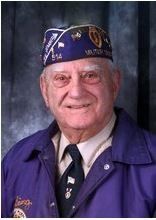Emmons Miller
A Bay City veteran says he “visited hell” on this day 65 years ago when his U.S. Army unit rolled up to the gates of a place synonymous with evil — Dachau.
On April 29, 1945, Emmons Miller was with the 16th Armored Division, which joined with the 7th Armored Division and 45th Infantry Division to roll through the gates of the first and longest-lived concentration camp, located about 10 miles northwest of Munich, Germany.
Top of Form
Bottom of Form
Miller, now age 90, called it “my trip into hell,” as he remembered the day he saw the horrific scenes of tens of thousands of dead and dying prisoners, mostly Jews and other ethnic people outlawed during the 12 years of the Third Reich.
While World War II in Europe was nearly ended, it didn’t come fast enough for many of the inmates who died in those last days from the ravages of disease and malnutrition before American medical personnel could help them.
Miller said the division was driving east through Germany and was ordered to move toward Munich, stopping short of it when they found the camp.
“We looked at these figures and we didn’t know what they were at first,” he said. “They were all bones walking and some would run toward us and fall down, but they couldn’t get up again.”
Miller said there were 70,000 prisoners at the death camp, some ambulatory, some dead and a lot of them near death.
“After a week of trying to save them, we could not, as they were nearly dead.”
His unit was ordered to pull out and move east and there was one lasting memory of Dachau he can’t shake to this day.
“As we drove away, we looked back and there was a prisoner who got out of the camp and was running after the truck. He couldn’t keep up and fell down. That’s the last thing I saw of the camp.”
As his division moved east, Miller’s unit liberated another prison camp before reaching Pilsen, Czechoslovakia, stopping the furthest east of any Allied unit. Military historians note that the Soviet Union’s Red Army took over that sector as the Allies pulled back into Germany.
According to data reported by the United States Holocaust Memorial Museum in Washington, D.C., there were actually about 35,000 inmates in the main Dachau camp, and an equal number spread out through about 10 satellite camps nearby. Before the Americans arrived, about 7,000 of the prisoners were taken out by their SS guards and forced on a death march to a camp further south. Those people were liberated nearly two weeks later.
During the war, about 28,000 prisoners died at Dachau and a larger unknown number died in the years prior to the war when it was used as a center for political prisoners when the Nazis gained power.
“It was awful,” said Miller. “It was something you never forget and it always is with me. I still can see the smoke and smell the odor. It never goes away
